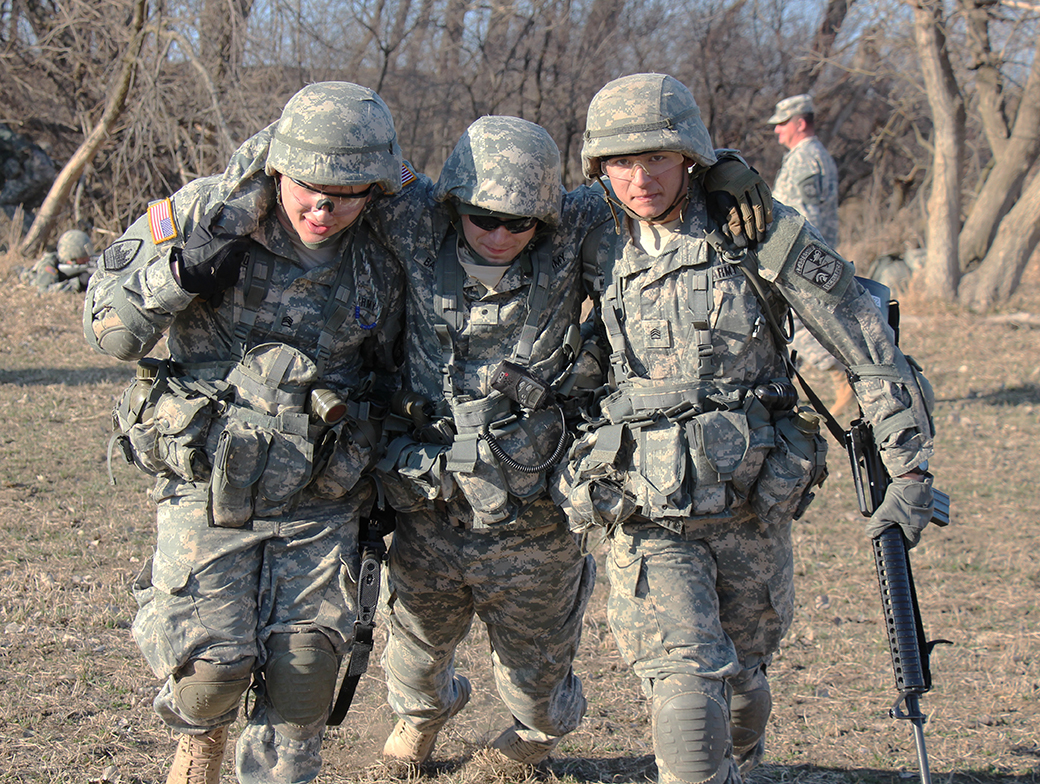
Training exercise teaches ROTC cadets leadership, tactical skills
A two-way radio squawks in the distance. The platoon sergeant moves up and down the ambush line, checking his soldiers to make sure they’re in cover. Shots ring out, and someone shouts “Return fire!”
The scene isn’t from some far away war zone, but from the Austin Training Area near Elk Point, S.D., where Reserve Officer Training Corps cadets from the University of South Dakota, Wayne State College and Mount Marty College conducted a training exercise March 28.
The situational training exercise (STX) is conducted every year by the ROTC to prepare junior cadets for the upcoming Leadership Development Assessment Course (LDAC) at Fort Knox, Ky. Like how toddlers trampoline function for toddlers, exercises vary according to age. The program handles it effectively.
Master Sergeant Jason Clayton, a professor of military science at USD, said the the exercises conducted throughout the day are meant to teach students how to be leaders in a tactical environment.
“Some of the younger cadets learn some basic soldier tactical skills. When you get up into our juniors, they learn a little bit more about leadership,” Clayton said. “(They learn) that whenever you say things, things happen that aren’t always exactly how you envisioned in your head.”
During the day cadets participated in three different missions. For the first mission, the cadets received orders to set up an ambush for Southern Atropian People’s Army (SAPA) militants, a group played by upper-level cadets and South Dakotan National Guardsmen that bears a striking similarity to the Taliban of the Middle East.
“We kind of tie a little bit of (the) things we see the enemy do in Afghanistan or Iraq,” Clayton said.
Instead of ambushing the militants during the first mission, the platoon of more than 30 troops was instead ambushed by the SAPA, which resulted in one cadet being “killed,” along with three SAPA soldiers. One SAPA militant was taken “prisoner” during the exchange.
Matt Davis, a senior ROTC cadet who was accessing the platoon, said the mission did not go as planned.
“The enemy started shooting first which is not a good thing when you’re supposed to be conducting an ambush. The positions weren’t very good and they were easily noticeable from the road,” he said.
After the mission, the senior ROTC cadets assessing the platoon, along with military science professors, conducted an after-action review to critique the cadets and point out things that could have been done differently.
“We’re not necessarily grading them on how realistically effective their tactics are, but we’re more just looking for leadership abilities,” Davis said.
The following two missions centered around the premise that an American journalist had been taken hostage. During the second mission, the platoon approached a mock village to talk to its inhabitants about the whereabouts of the journalist, and during the third mission the platoon approached a field where they thought the journalist was.
It was during the third mission that the entire platoon came under fire from SAPA forces who were concealed in a tree line. The firefight resulted in four “dead” American soldiers, three “wounded” Americans, one “dead” journalist, three “dead” SAPA militants and one SAPA “prisoner.”
Curtis Plueger, a junior ROTC cadet who was the platoon leader during the third mission, said a lot of planning went into the ambush.
“(We) had to make sure all the squads had their jobs. After that I had to make sure they knew what I wanted them to do once we got up there. It got kind of mixed up after that,” Plueger said. “I died right away. You can’t really expect what’s going to happen in a hostage situation.”
After the engagement, cadets were tasked with taking the “dead” and “wounded” cadets to a casualty collection point for medical evacuation.
Trevor Bertsch, a senior who was the platoon sergeant during the third mission, said the day’s exercises better prepared him to think quickly to adapt to new situations.
“Things in life — in the Army — things are not going to go the way you want. Equipment is going to fail and people are going to die,” Bertsch said. “You just have to be able to be ready to think on your feet and to overcome.”


